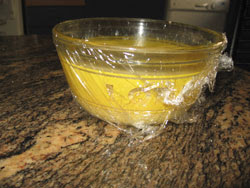Here are the ingredients and the directions.
For the soaker:
1 cup cornmeal
1 cup water room temperature
For the dough:
4 1/2 cups bread flour
2 teaspoons instant yeast
1 cup lukewarm water
1 1/2 teaspoons salt
6 tablespoons molasses
2 tablespoons shortening or unsalted butter room temperature
cornmeal for dusting
It's now Wednesday around lunchtime as I write these words but I started the process of making the bread on Sunday evening. Anadama Bread is a full-flavored hearty loaf that utilizes both cornmeal and molasses. It needs to mature and ferment in order to develop its full flavor and character. I started by placing the cornmeal with water in a glass bowl, with a short stir to make sure it was completely covered.
Then it stood on the counter, covered with plastic wrap for two days.
Finally, it was ready to become bread. The sweet aroma of ferment greeted me when I lifted the plastic cover so I knew this was going to be great. Into the mixer bowl it went, along with, flour, molasses, oil, yeast, water and salt. After a short mix (5 or so minutes) to combine, I let it stand for 10 minutes for the yeast to develop. Then the extra added flour is mixed to make a soft, tacky (but not sticky) dough.
Cover this and let it sit for another 60 to 90 minutes, or until it has double in size.
This risen dough is also a lot smoother as the gluten is developing very nicely, thank you. It also smells incredible. Now is the time to shape the loaves. Gently, degas the dough. Cut the dough into two equal pieces and shape into loaves (batard shape). Place this dough into a lightly greased loaf-style pan and let it rise again for about 45 minutes to an hour,
or until the loaves reach the top of the pan and, maybe just maybe, peek over the edge slightly. To keep the bread from drying out and forming a crust, you can lightly spray the dough with oil.
About 15 minutes before the rise is finished, pre-heat the oven to 350 F (180 C). Place the loaf pans gently on a baking sheet, spray the loaves lightly with water and sprinkle cornmeal over the top. When they have risen, and the oven is hot, it's time for the magic. Place the loaves on a center rack for about 20 minutes. Then turn them 180 degrees to ensure even baking. After the turn, bake for another 15 or twenty minutes. They will sound hollow when tapped on the bottom and be a deep brown, bottom and sides too.
After baking take the loaves out of the pan and place on a rack to cool completely. They will have a nice hard crust that softens as it cools.
If you're like me and can't wait to taste freshly baked bread you'll love this loaf. The crumb is soft and rich from the molasses and the fermented cornmeal. The crust is a little chewy also with cornmeal that adds a nice texture. Slather some butter on this while still slightly warm, you won't be sorry!
Fresh Baked Anadama Bread









Now I'm hungry!
ReplyDeleteOmigosh, yum! You had me at "Slather some butter on this while still slightly warm" :)
ReplyDelete